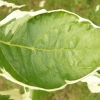Features
Branches grow in layers, giving this medium sized, deciduous tree a tiered appearance when in leaf. The foliage is mid green with thick, creamy-white borders and turns yellow in autumn. Clusters of small cream/white flowers appear in summer, followed by attractive fruits which turn from green to pink then to deep purple/black.
What to use it for
A great focal point (when the foliage is out) and good for low maintenance gardening. Has wildlife benefit as birds eat the berries.
How to look after it
Requires little or no care beyond the initial training (see below).
How to prune it
Train as a central leader standard tree, keeping the trunk clear for about a quarter or a third of the tree’s height. Once established keep pruning to a minimum, just removing dead, diseased, damaged or reverting growth. Any pruning should be carried out from autumn to early spring. It does not like to be hard pruned.
How to propagate it
Softwood cuttings can be taken in late spring or early summer, or plants can be grafted.
Common problems
Cornus anthracnose and die back can be a problem, as can viral diseases. Horse chestnut scales may also infest the plant.
Reversion can occasionally affect the variegated foliage.
If planted in an exposed site the wind can effectively ‘prune‘ the windward side of the tree, reducing its growth and giving the plant a lopsided appearance. It is difficult to rectify this once the damage has been done.
Other useful information
This plant has been given the Award of Garden Merit by the RHS.









